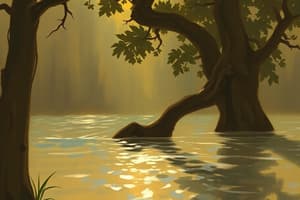Podcast
Questions and Answers
What distinguishes Impressionism and Abstract Expressionism from traditional art movements?
What distinguishes Impressionism and Abstract Expressionism from traditional art movements?
- Use of bright, vivid colors
- Incorporation of religious themes
- Emphasis on abstraction and individuality (correct)
- Strict adherence to representational techniques
Which painting technique was favored by Renaissance artists for its contribution to realistic portraits and landscapes?
Which painting technique was favored by Renaissance artists for its contribution to realistic portraits and landscapes?
- Oil Paint (correct)
- Watercolor
- Tempera
- Acrylic Paint
Which sculpture style emphasizes drama, movement, and emotion in its creations?
Which sculpture style emphasizes drama, movement, and emotion in its creations?
- Abstract Sculpture
- Baroque Sculpture (correct)
- Classical Sculpture
- Cubist Sculpture
Which painting medium gained popularity in the mid-twentieth century due to its fast-drying nature and bright colors?
Which painting medium gained popularity in the mid-twentieth century due to its fast-drying nature and bright colors?
What characterizes Cubist Sculpture as introduced by Picasso?
What characterizes Cubist Sculpture as introduced by Picasso?
What is the main focus of art history?
What is the main focus of art history?
During the Medieval Period, what type of themes were prominent in Western European art?
During the Medieval Period, what type of themes were prominent in Western European art?
Which ancient civilization focused on monumental stone statues, wall paintings, and jewelry made from precious metals like gold?
Which ancient civilization focused on monumental stone statues, wall paintings, and jewelry made from precious metals like gold?
What was a key emphasis of painters during the Renaissance period?
What was a key emphasis of painters during the Renaissance period?
Which art style is known for its elaborate, dramatic, and emotionally charged aesthetics during the 17th and early 18th centuries?
Which art style is known for its elaborate, dramatic, and emotionally charged aesthetics during the 17th and early 18th centuries?
Flashcards are hidden until you start studying
Study Notes
Fine Arts Overview
Fine arts encompass creative disciplines that celebrate human imagination through various forms of visual expression. As we delve into the diverse world of fine arts, let's explore three key aspects—art history, painting techniques, and sculpture styles.
Art History
Art history is the study of artistic works across time, cultures, and geographies. This discipline provides valuable insights into how humans have expressed themselves visually throughout history. Several major periods and movements influence our understanding of fine arts today. For example:
-
Early Civilizations: From ancient Egypt, Mesopotamia, Greece, Rome, and beyond, civilizations developed unique artistic expressions that evolved over centuries.
- In Ancient Egypt, artists focused on monumental stone statues, wall paintings, and jewelry crafted from precious metals like gold.
-
Medieval Period: Throughout the Middle Ages, religious themes dominated Western European art, with artists such as Giotto di Bondone pioneering new approaches to perspective and emotional expression.
-
Renaissance: During this period, painters emphasized realism, anatomy, linear perspective, and classical motifs. Notable figures included Leonardo da Vinci and Michelangelo.
-
Baroque: Known for its elaborate, dramatic, and emotionally charged aesthetics, Baroque art was prominent during the 17th and early 18th centuries.
-
Impressionism & Abstract Expressionism: These modernist movements emphasize abstraction, subjective perceptions, and individuality. Impressionists like Claude Monet challenged traditional representational painting techniques, while abstract expressionists went further, creating nonrepresentational images.
Each epoch has contributed uniquely to fine arts, inspiring contemporary artists to innovate and push boundaries within their own practice.
Painting Techniques
Painting is one of the oldest known fine arts, with innovative practices constantly emerging since antiquity. Let's examine some significant painting methods:
-
Oil Paint: Introduced around the 15th century, oil paint offers vibrant colors and extended drying times compared to earlier mediums. Oil painting allowed Renaissance artists to experiment more freely, contributing to realistic portraits and landscapes.
-
Acrylic Paint: Acrylic paint became popular in the mid-twentieth century due to its fast-drying nature, water solubility, and ability to produce bright, vivid colors. Contemporary artists often favor acrylics because they allow rapid creation and modification of artwork.
-
Watercolor: Watercolors require skillful application of pigment mixed with water. Because of their transparency and spontaneous character, these colors inspired countless landscape artists throughout history.
Sculpture Styles
Sculpting involves shaping matter into lifelike representations or abstract compositions designed to engage viewers aesthetically and conceptually. Some essential sculpture styles include:
-
Classical Sculpture: Focuses on capturing ideal proportions and form based on principles set forth by Greek architect Vitruvius in his treatise De Architectura. Famous pieces of Classical sculptures include David, created by Michelangelo.
-
Baroque Sculpture: Emphasizes drama, movement, and emotion. Examples can be seen in Bernini's Ecstasy of Saint Teresa.
-
Cubist Sculpture: Cubism introduced geometric fragmentation of figures and objects. Picasso produced several notable examples of cubist sculpture.
In conclusion, exploring fine arts allows us to understand the evolving relationship between humankind and creativity across millennia. By investigating historical periods, appreciating distinctive painting techniques, and admiring striking sculptural masterpieces, we gain insight into cultural heritage and the limitless potential of artistic expression.
Studying That Suits You
Use AI to generate personalized quizzes and flashcards to suit your learning preferences.



